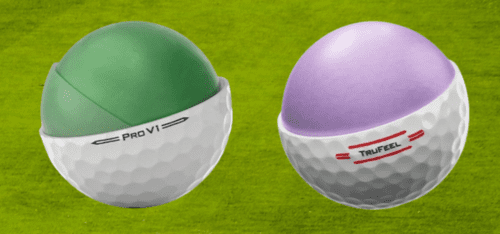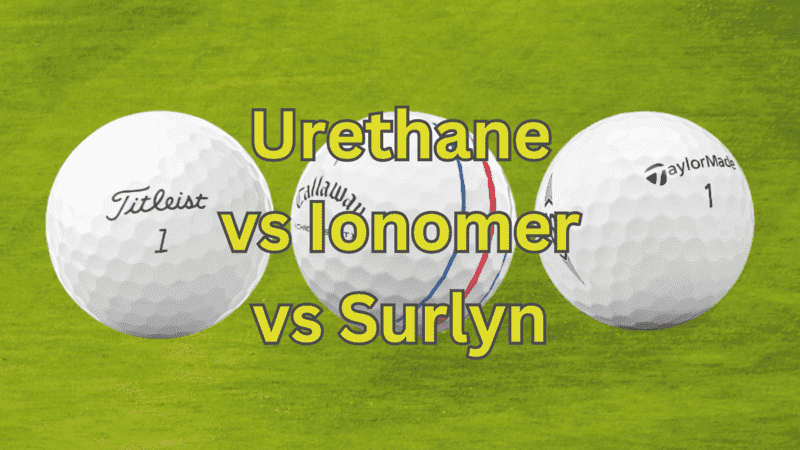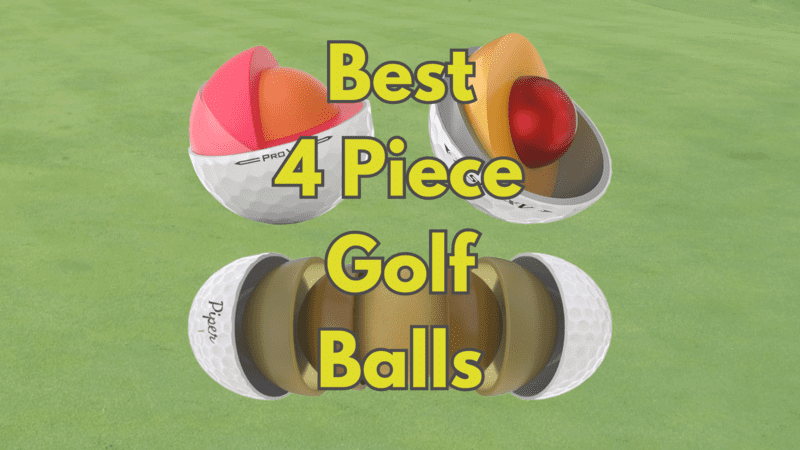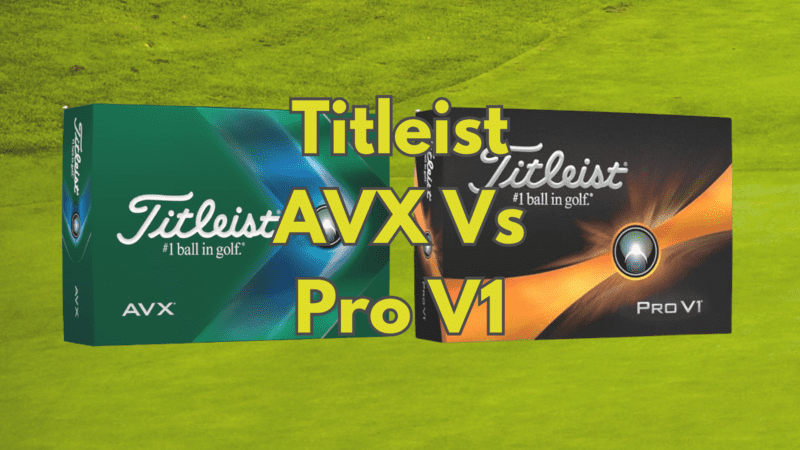Golf, a game that marries precision with passion, often hinges on choices beyond swing technique and club selection. A crucial decision, often underestimated, lies in the type of golf ball used. While many golfers may fixate on brand names or the number of layers, the true game-changer lies in the cover material. But what exactly does Urethane vs Ionomer vs Surlyn mean?
In this exploration, we’ll delve into the intricacies of three distinct cover materials: urethane, ionomer, and Surlyn. Each material comes with its own set of characteristics, influencing the ball’s performance in unique ways. From the nuanced feel of urethane to the durability of Surlyn, understanding these materials is the key to unlocking the full potential of your game.
Beyond the green aesthetics, these materials embody the intersection of science and golfing prowess. The cover material determines the ball’s behavior in flight, its interaction with the clubface, and its responsiveness on the green. Join us on this journey as we demystify the often-overlooked world of golf ball covers. This offers insights that will empower you to make informed decisions on the course. So which is best Urethane vs Ionomer vs Surlyn?
Urethane: The Precision Player’s Pick
What Is Urethane?
Urethane, a versatile polymer, results from the reaction between isocyanates and polyols. Also known as polyurethane, it exhibits exceptional durability, flexibility, and resistance to abrasion. Commonly used in coatings, adhesives, and foams, urethane’s diverse applications span industries such as automotive, construction, and furniture manufacturing.
What Sets Urethane Apart?
Urethane, a polymer known for its malleability when subjected to heat, stands as the cover of choice for many low handicappers and professionals. Its distinctive characteristic lies in the level of control and precision it affords. This makes it the go-to for golfers seeking optimal spin and finesse.
The ‘Schniiiiick’ Factor: Exploring the Feel and Sound
Urethane introduces a sensory element to the game, with the unmistakable ‘schniiiiick’ sound resonating when a well-compressed shot takes flight. This auditory signature, often rare but immensely satisfying, accompanies a feel that translates into heightened control and responsiveness, especially on the greens.
Performance Characteristics for Low Handicappers
Tailored for the seasoned player, urethane offers a higher compression rating compared to its counterparts. This attribute translates to increased spin, crucial for shaping shots and maintaining control, especially with faster swing speeds. The precise molding process allows for a versatile range of design possibilities, ensuring golfers can fine-tune their game to meet specific demands.
Notable Urethane Ball Examples
Urethane’s dominance in the premium golf ball market is exemplified by renowned models such as the Titleist Pro V1, Titleist Pro V1x, Srixon Z-Star XV, TaylorMade TP5, Bridgestone Tour B RXS, and Callaway Hex Black Tour. These balls, often found in the bags of professionals, showcase the pinnacle of urethane’s performance capabilities.
Ionomer: The Versatile and Forgiving Option
What Is Ionomer?
Ionomer refers to a type of polymer containing ionic groups, enhancing its strength and transparency. Typically used in packaging, sports equipment, and golf balls, ionomers exhibit a unique balance of toughness and elasticity. Their exceptional impact resistance and clarity make them valuable in various industries.
Durability and Affordability of Ionomer
Enter ionomer, a polymer designed to cover golf balls with an emphasis on durability and affordability. Ionomer balls stand out as a resilient choice, capable of withstanding the rigors of play, making them an attractive option for golfers conscious of both their budget and the longevity of their equipment.
Long-Distance Play and Reduced Spin
Where ionomer truly shines is in its ability to provide golfers with impressive distance off the tee. The material’s inherent characteristics result in reduced spin, particularly beneficial for those still mastering control. This forgiveness off the tee translates into straighter shots, mitigating the impact of hooks and slices for players working to refine their skills.
Softened Ionomer: Finding the Balance
To cater to a broader range of preferences, some ionomer balls are engineered with a softer feel. While this compromises some durability, it adds an element of touch and responsiveness, addressing the desire for improved feel without sacrificing the overall forgiveness that ionomer offers.
Highlighting Popular Ionomer Ball Models
Among the notable ionomer ball models are Srixon Soft Feel, Titleist TruFeel, Wilson Duo Soft+, Bridgestone e12 Contact, TaylorMade Project, and Nike RZN Tour. These options showcase the versatility of ionomer. Thus appealing to golfers seeking a balance between cost-effectiveness, durability, and playability.
Surlyn: Strength and Straight Shots
What Is Surlyn?
Surlyn is a thermoplastic resin known for its clarity, toughness, and chemical resistance. Comprising copolymers of ethylene and methacrylic acid, Surlyn is commonly used in packaging, golf ball covers, and protective coatings. Its versatility stems from a combination of strength and aesthetic appeal, making it a popular material in diverse applications.
The Origins of Surlyn and Its Strengths
Derived from the innovative polymer developed by DuPont, Surlyn stands as a brand of ionomer that takes durability to new heights. Initially created by the same minds behind Lycra, Teflon, Mylar, and more, Surlyn-covered golf balls are engineered to endure the challenges presented by high handicappers.
Targeting High Handicappers: Distance Over Spin
Surlyn balls are tailored for golfers prioritizing straight, powerful shots off the tee. The material’s inherent strength ensures that these balls can withstand the impact of errant shots, making them an ideal choice for players still developing their swing and accuracy.
Cost-Effectiveness and Durability
While Surlyn may not boast the same level of finesse as urethane, it makes up for it in cost-effectiveness and durability. Often found in two-piece constructions, Surlyn balls provide an affordable entry point for golfers who value distance and durability without compromising their wallets.
Notable Surlyn Ball Examples
Examples of Surlyn-covered balls include Slazenger Raw Distance, Titleist Velocity, Volvik Vista iS, Callaway Hex Warbird, and Maxfli Revolution Low Compression. These models showcase Surlyn’s appeal to golfers in the higher handicap range, emphasizing distance, durability, and cost efficiency.
Choosing the Right Cover for Your Game
Many golfers are confused by the choice of golf ball covers. Urethane vs Ionomer vs Surlyn is a battle that can leave you scratching you head. So, let’s have a look at the factors to consider when making this decision.

Tailoring Ball Selection to Handicap Levels
Higher Handicap Golfer (20+): Surlyn’s Strength and Affordability: The robustness of Surlyn becomes a key asset for golfers with higher handicaps. Its durability helps minimize the impact of wayward shots, reducing the chances of losing balls in rough terrain.
Cost-effectiveness makes Surlyn an appealing choice for those who may not be seeking the finesse of spin but prioritize a ball that can endure the challenges presented by a less predictable game.
Medium Handicap Golfer (10-20): Urethane for Touch, Ionomer for Distance: Urethane provides the touch and grip needed for those hitting fairways consistently, enhancing control around the green. For those struggling with distance or direction, ionomer offers a balance by providing more distance and reducing spin for improved accuracy off the tee.
Low Handicap Golfer (10 and lower): Multi-Layered Urethane for Precision: As golfers progress into single-digit handicaps, the need for precision becomes paramount. Multi-layered urethane balls, exemplified by models like Pro V1, Callaway Chrome Soft, Taylormade TP5, and Srixon Z-Star, offer the optimal combination of spin, control, and feel around the green.
Considerations Beyond Handicap
Budget Constraints: Ionomer balls, being more cost-effective, cater to golfers on a budget without compromising essential performance attributes. For those seeking premium performance, urethane might be worth the investment.
Budget can be a significant factor when choosing between Urethane vs Ionomer vs Surlyn.
Personal Preferences and Playstyle: Understanding personal preferences, such as the desire for feel off the putter’s face or the need for forgiveness off the tee, plays a crucial role in selecting the right ball. Balancing these preferences with the performance attributes of each cover material is key.
Practical Tips for Testing and Selecting the Ideal Ball
On-Course Testing: Conducting on-course tests with different ball types can provide valuable insights into how each performs in real-game scenarios. Pay attention to factors like distance, feel, and control.
Consulting with Golf Professionals: Seeking advice from golf professionals or conducting a fitting session can offer personalized recommendations based on individual swing characteristics and playing styles.
Final Thoughts
In the intricate world of golf ball covers, the choice between urethane vs ionomer vs Surlyn emerges as a pivotal factor influencing performance.
Urethane, with its precision and sensory appeal, suits low handicappers seeking control and finesse.
Ionomer, versatile and forgiving, caters to those valuing durability and affordability, with options for varied feel.
Surlyn, renowned for strength and straight shots, becomes a cost-effective choice for higher handicappers prioritizing distance.
Tailoring ball selection to handicap levels and considering personal preferences ensures an optimal match. Through on-course testing and professional advice, golfers can unlock their game’s full potential, making informed choices for a seamless blend of skill and equipment.
Happy Golfing!



